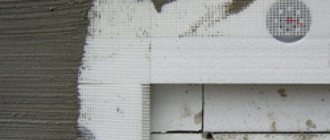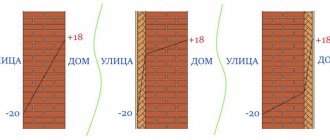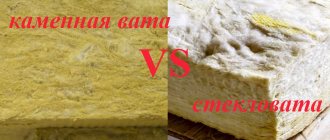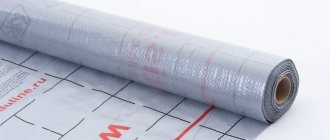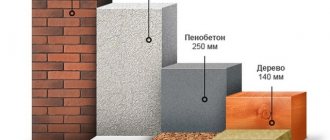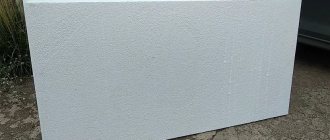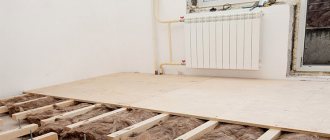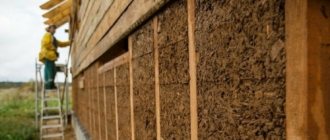Lifetime
Most manufacturers indicate a service life of 20-30 years. This is the warranty time during which the useful properties of the material are within acceptable limits. Recent studies by European scientists have shown surprising and encouraging results. When demolishing houses built 40-50 years ago using polyurethane foam, scientists found that its properties remained virtually unchanged. The structure and texture remained the same as originally. Further laboratory studies only confirmed the durability of this material.
Environmental friendliness
An important parameter that modern builders are paying more and more attention to. During the production process, polyurethane foam goes from liquid to solid in 30 seconds
After this, harmful fumes from its surface stop. If it is heated to 450 Cº, carbon dioxide and carbon monoxide will begin to be released. However, the same thing can be observed when wood is heated. Polyurethane foam does not emit compounds harmful to the human body
What does thermal conductivity depend on?
The ability of polystyrene foam boards to retain heat depends mainly on two factors: density and thickness. The first indicator is determined by the number and size of air chambers that make up the structure of the material. The denser the slab, the greater the thermal conductivity coefficient it will have.
Density dependence
In the table below you can see exactly how the thermal conductivity of expanded polystyrene depends on its density.
| Density (kg/m3) | Thermal conductivity (W/mK) |
| 10 | 0.044 |
| 15 | 0.038 |
| 20 | 0.035 |
| 25 | 0.034 |
| 30 | 0.033 |
| 35 | 0.032 |
The background information presented above, however, most likely, can only be useful to home owners who have used polystyrene foam to insulate walls, floors or ceilings for quite some time. The fact is that when producing modern grades of this material, manufacturers use special graphite additives, as a result of which the dependence of thermal conductivity on the density of the plates is reduced to almost nothing. You can verify this by looking at the indicators in the table:
| Brand | Thermal conductivity (W/mK) |
| EPS 50 | 0.031-0.032 |
| EPS 70 | 0.033-0.032 |
| EPS 80 | 0.031 |
| EPS 100 | 0.03-0.033 |
| EPS 120 | 0.031 |
| EPS 150 | 0.03-0.031 |
| EPS 200 | 0.031 |
Dependence on thickness
Of course, the thicker the material, the better it retains heat. For modern expanded polystyrene, the thickness can range from 10-200 mm. According to this indicator, it is usually classified into three large groups:
- Plates up to 30 mm. This thin material is usually used to insulate partitions and interior walls of buildings. Its thermal conductivity coefficient does not exceed 0.035 W/mK.
- Material up to 100 mm thick. Expanded polystyrene of this group can be used for cladding both external and internal walls. Such stoves retain heat very well and are successfully used even in regions of the country with a harsh climate. For example, a material 50 mm thick has a thermal conductivity of 0.031-0.032 W/Mk.
- Expanded polystyrene with a thickness of more than 100 mm. Such dimensional slabs are most often used for the manufacture of formwork when pouring foundations in the Far North. Their thermal conductivity does not exceed 0.031 W/mK.
Calculation of the required material thickness
It is quite difficult to accurately calculate the thickness of polystyrene foam needed to insulate a house. The fact is that when performing this operation, a lot of different factors should be taken into account. For example, such as the thermal conductivity of the material chosen for the construction of insulated structures and its variety, the climate of the area, the type of cladding, etc. However, it is still possible to approximately calculate the required thickness of the slabs. To do this you will need the following reference data:
- an indicator of the required thermal resistance of enclosing structures for a given specific region;
- thermal conductivity coefficient of the selected brand of insulation.
Actually, the calculation itself is carried out according to the formula R=p/k, where p is the thickness of the foam, R is the thermal resistance index, k is the thermal conductivity coefficient. For example, for the Urals the R indicator is 3.3 m2•°C/W. Let’s say that a material of the EPS 70 brand with a thermal conductivity coefficient of 0.033 W/mK is selected for wall insulation. In this case, the calculation will look like this:
That is, the thickness of the insulation for external enclosing structures in the Urals should be at least 100 mm. Typically, home owners in cold regions sheathe walls, ceilings and floors with two layers of 50 mm polystyrene foam. In this case, the slabs of the upper layer are positioned so that they overlap the seams of the lower one. This way you can get the most effective insulation.
What is thermal conductivity
You can find out how well a material can retain heat by looking at its thermal conductivity coefficient. This indicator is determined very simply. Take a piece of material with an area of 1 m2 and a thickness of a meter. One of its sides is heated, and the opposite side is left cold. In this case, the temperature difference should be tenfold. Next, they look at how much heat reaches the cold side in one hour. Thermal conductivity is measured in watts, divided into the product of a meter and a degree (W/mK). When purchasing expanded polystyrene for cladding a house, loggia or balcony, you should definitely look at this indicator.
How to calculate wall thickness
In order for the house to be warm in winter and cool in summer, it is necessary that the enclosing structures (walls, floor, ceiling/roof) must have a certain thermal resistance. This value is different for each region. It depends on the average temperatures and humidity in a particular area.
Thermal resistance of enclosing structures for regions of Russia
In order for heating bills not to be too high, it is necessary to select building materials and their thickness so that their total thermal resistance is not less than that indicated in the table.
Calculation of wall thickness, insulation thickness, finishing layers
Modern construction is characterized by a situation where the wall has several layers. In addition to the supporting structure, there is insulation and finishing materials. Each layer has its own thickness. How to determine the thickness of insulation? The calculation is simple. Based on the formula:
Formula for calculating thermal resistance
R—thermal resistance;
p—layer thickness in meters;
k is the thermal conductivity coefficient.
First you need to decide on the materials that you will use during construction. Moreover, you need to know exactly what type of wall material, insulation, finishing, etc. will be. After all, each of them makes its contribution to thermal insulation, and the thermal conductivity of building materials is taken into account in the calculation.
First, the thermal resistance of the structural material (from which the wall, ceiling, etc. will be built) is calculated, then the thickness of the selected insulation is selected based on the “residual” principle. You can also take into account the thermal insulation characteristics of finishing materials, but usually they are a plus to the main ones. This is how a certain reserve is laid down “just in case.” This reserve allows you to save on heating, which subsequently has a positive effect on the budget.
We advise you to study - How to choose a kitchen sink from all the variety
An example of calculating the thickness of insulation
Let's look at it with an example. We are going to build a brick wall - one and a half bricks long, and we will insulate it with mineral wool. According to the table, the thermal resistance of walls for the region should be at least 3.5. The calculation for this situation is given below.
- First, let's calculate the thermal resistance of a brick wall. One and a half bricks is 38 cm or 0.38 meters, the thermal conductivity coefficient of brickwork is 0.56. We calculate using the above formula: 0.38/0.56 = 0.68. A wall of 1.5 bricks has this thermal resistance.
- We subtract this value from the total thermal resistance for the region: 3.5-0.68 = 2.82. This value must be “added” with thermal insulation and finishing materials.
- We calculate the thickness of mineral wool. Its thermal conductivity coefficient is 0.045. The thickness of the layer will be: 2.82 * 0.045 = 0.1269 m or 12.7 cm. That is, to ensure the required level of insulation, the thickness of the mineral wool layer must be at least 13 cm.
If the budget is limited, you can take 10 cm of mineral wool, and the missing amount will be covered with finishing materials. They will be inside and outside. But, if you want your heating bills to be minimal, it is better to use the finishing as a “plus” to the calculated value. This is your reserve during the lowest temperatures, since thermal resistance standards for enclosing structures are calculated based on the average temperature over several years, and winters can be abnormally cold
Therefore, the thermal conductivity of building materials used for finishing is simply not taken into account
Comparison using a table
| N | Name | Density | Thermal conductivity | Price, euro per cubic meter | Energy costs for | ||
| kg/cub.m | min | Max | European Union | Russia | kW*h/cubic m. | ||
| 1 | cellulose wadding | 30-70 | 0,038 | 0,045 | 48-96 | 15-30 | 6 |
| 2 | fibreboard | 150-230 | 0,039 | 0,052 | 150 | 800-1400 | |
| 3 | wood fiber | 30-50 | 0,037 | 0,05 | 200-250 | 13-50 | |
| 4 | flax fiber whales | 30 | 0,037 | 0,04 | 150-200 | 210 | 30 |
| 5 | foam glass | 100-150 | 0.05 | 0,07 | 135-168 | 1600 | |
| 6 | perlite | 100-150 | 0,05 | 0.062 | 200-400 | 25-30 | 230 |
| 7 | cork | 100-250 | 0,039 | 0,05 | 300 | 80 | |
| 8 | hemp, hemp | 35-40 | 0,04 | 0.041 | 150 | 55 | |
| 9 | cotton wool | 25-30 | 0,04 | 0,041 | 200 | 50 | |
| 10 | sheep's wool | 15-35 | 0,035 | 0,045 | 150 | 55 | |
| 11 | duck down | 25-35 | 0,035 | 0,045 | 150-200 | ||
| 12 | straw | 300-400 | 0,08 | 0,12 | 165 | ||
| 13 | mineral (stone) wool | 20-80 | 0.038 | 0,047 | 50-100 | 30-50 | 150-180 |
| 14 | glass fiber wool | 15-65 | 0,035 | 0,05 | 50-100 | 28-45 | 180-250 |
| 15 | expanded polystyrene (pressless) | 15-30 | 0.035 | 0.047 | 50 | 28-75 | 450 |
| 16 | extruded polystyrene foam | 25-40 | 0,035 | 0,042 | 188 | 75-90 | 850 |
| 17 | polyurethane foam | 27-35 | 0,03 | 0,035 | 250 | 220-350 | 1100 |
The indicator of thermal conductivity properties is the main criterion when choosing an insulation material. All that remains is to compare the pricing policies of different suppliers and determine the required quantity.
Insulation is one of the main ways to obtain a structure with the required energy efficiency. Before making your final choice, carefully determine the conditions of use and, armed with the table provided, make the right choice.
What you need to know about the thermal conductivity of polystyrene foam
The thermal conductivity of polystyrene foam is quite low, because the air that is at the base of the material also has such characteristics. Therefore, the described insulation parameter varies from 0.037 to 0.043 W/mK; as for air, this characteristic is 0.027 W/mK.
Expanded polystyrene is manufactured in accordance with GOST 15588-86 and is characterized by excellent energy saving, increased service life, and can reduce heating costs and protect against freezing. Such properties are preserved even when exposed to low temperatures and high humidity, so expanded polystyrene can be used in warehouse conditions, as well as in refrigeration equipment structures.
The thermal conductivity of polystyrene foam is low, so this material can be used not only for interior but also for exterior decoration. However, this characteristic will vary depending on the density. The higher it is, the higher the styrene content, the worse the polystyrene foam will retain heat. For example, if we are talking about extruded polystyrene foam, then its thermal conductivity will be 0.028 W/mK, because styrene granules in this case are in the structure of a single sheet, and there are no gaps between them.
What is expanded polystyrene
This material is made on approximately the same principle as any other foam insulation. First, liquid styrene is poured into a special installation. After adding a special reagent to it, a reaction occurs with the release of a large amount of foam. The finished foamed thick mass is passed through a molding machine until it hardens. The result is sheets of material with a huge number of small air chambers inside.
This structure of the boards explains the high insulating qualities of polystyrene foam. After all, air, as you know, retains heat very well. There are types of polystyrene foam, the cells of which also contain other gases. However, the most effective insulators are still considered to be slabs with air chambers.
The cells included in the structure of expanded polystyrene can have a size from 2 to 8 mm. Their walls account for approximately 2% of the mass of the material. Thus, polystyrene foam is 98% air.
Advantages and disadvantages of the material
Polystyrene insulation has the following advantages:
- does not create additional load on the foundation of the building and supporting structures;
- durability - the service life of the material is at least 40 years, while it does not lose its characteristics;
- ease of transportation and installation;
- good adhesion and interaction with adhesives;
- resistance to temperature changes and exposure to most aggressive environments.
Also, most modern types of polystyrene foam insulation are treated with special compounds that protect the material from rodents and pests.
At the same time, polystyrene foam also has disadvantages.
Low vapor permeability. To avoid the accumulation of steam indoors when using polystyrene foam as insulation, it is necessary to equip it with good supply and exhaust ventilation.
Not resistant to UV radiation. For this reason, the foam must be hidden from exposure to sunlight.
Loss of performance qualities when interacting with solvents, which does not allow applying paints and varnishes to EPS.
Low resistance to external mechanical influences
Polystyrene foam is a fairly fragile material, so when working with it, care must be taken so that it does not break or crack.
It is not the material itself that is toxic, but the fumes of stylol, which decrease over time and do not exceed the maximum permissible and safe for humans. Therefore, experts advise using PPP, which has been “staying” in the warehouse for quite a long time. The flammability of expanded polystyrene depends on the production technology. For example, polymer granules filled with carbon dioxide have the ability to self-extinguish.
Other selection criteria
When choosing a suitable product, not only thermal conductivity and the price of the product should be taken into account.
You need to pay attention to other criteria:
- volumetric weight of insulation;
- dimensional stability of this material;
- vapor permeability;
- flammability of thermal insulation;
- soundproofing properties of the product.
Let's take a closer look at these characteristics. Let's start in order.
Volumetric weight of insulation
Volumetric weight is the mass of 1 m² of a product. Moreover, depending on the density of the material, this value can be different - from 11 kg to 350 kg.
Such thermal insulation will have a significant volumetric weight
The weight of thermal insulation must definitely be taken into account, especially when insulating a loggia. After all, the structure on which the insulation is attached must be designed for this weight. Depending on the mass, the method of installing heat-insulating products will also differ.
For example, when insulating a roof, lightweight insulation materials are installed in a frame of rafters and sheathing. Heavy specimens are mounted on top of the rafters, as required by the installation instructions.
Form stability
This parameter means nothing more than the creaseability of the product used. In other words, it should not change its size during its entire service life.
Any deformation will result in heat loss
Otherwise, deformation of the insulation may occur. And this will already lead to a deterioration in its thermal insulation properties. Research has proven that heat loss can be up to 40%.
Vapor permeability
According to this criterion, all insulation materials can be divided into two types:
- “cotton wool” – heat-insulating materials consisting of organic or mineral fibers. They are vapor permeable because they easily allow moisture to pass through them.
- “foams” are heat-insulating products made by hardening a special foam-like mass. They do not allow moisture to pass through.
Depending on the design features of the room, materials of the first or second type can be used. In addition, vapor-permeable products are often installed with your own hands along with a special vapor barrier film.
Flammability
It is highly, highly desirable that the thermal insulation used is non-flammable. An option is allowed when it is self-extinguishing.
But, unfortunately, in a real fire, even this will not help. At the epicenter of the fire, even things that do not light up under normal conditions will burn.
Main characteristics of insulation
Let us first provide the characteristics of the most popular thermal insulation materials, which you should first pay attention to when choosing. Comparison of insulation by thermal conductivity should be made only on the basis of the purpose of the materials and room conditions (humidity, presence of open fire, etc.)
We have further arranged in order of importance the main characteristics of insulation.
Comparison of building materials
Thermal conductivity. The lower this indicator, the less thermal insulation layer is required, which means that insulation costs will also be reduced.
Moisture permeability. The lower permeability of the material to moisture vapor reduces the negative impact on the insulation during operation.
Fire safety. Thermal insulation should not burn or emit toxic gases, especially when insulating a boiler room or chimney.
Durability. The longer the service life, the cheaper it will cost you during operation, since it will not require frequent replacement.
Environmentally friendly. The material must be safe for humans and the environment.
Comparison of insulation materials. Thermal conductivity table
Comparison of foam block, mineral wool and polystyrene foam by thermal conductivity
The table above comparing thermal insulation by thermal conductivity gives a complete picture of which material is best to use. All that remains is to compare the data from the thermal conductivity table with the cost of thermal insulation from suppliers. In this case, it is necessary to accurately calculate the required thickness of insulation when using various materials in order to select the required amount of material.
Scope of application of EPPS
Comparison of the required amount of insulation.
Another advantage of the material is its wide range of applications. Low thermal conductivity allows it to be used in road construction as insulating bases. Modern refrigeration units cannot do without the use of this material. In addition, it is actively used in the process of reconstructing heaving sections of highways.
The low thermal conductivity of the insulation allows it to be used in agriculture as a heat insulator on farms.
EPPS is widespread in the field of industrial and civil construction.
Among the new extensive areas of application of XPS, individual construction can be distinguished. A particularly promising area is the production of sandwich panels. This material is no less popular among individual developers. For example, when installing a roof, the slabs are laid over waterproofing, which additionally protects it from damage and temperature changes. And when carrying out reconstruction work, expanded polystyrene allows you to reduce costs. Moreover, it is permissible to carry out this kind of process when the existing heat-insulating layer has become unusable.
We advise you to study - How to choose a chainsaw - detailed instructions
If it is intended to insulate a pitched roof, extruded polystyrene foam is laid on top of the rafters.
If it is necessary to insulate a wooden floor, heat insulation slabs must be laid between the rough and finishing layers, and fixation must be made between the joists. This allows for minimal heat loss through the floor. Sometimes it is necessary to insulate the floor of the first floor. The effectiveness of EPS in this case can be increased by laying the material in two layers, moving the sheets to overlap the seams. In this case, the EP slabs will be located between the waterproofing membrane and the screed. The material will guarantee not only excellent thermal protection, but also hydro- and vapor barrier, which will prevent the penetration of moisture from the underground.
EPS can be used in tandem with a heated floor system. This is possible due to the excellent strength characteristics of the plates. In this case, laying must be done on the interfloor ceiling, protecting it all with a dividing screed.
Due to its characteristics, EPS can be used when constructing the outer insulation layer of the foundation without the use of protection. The slabs will perform functions even in conditions that differ in groundwater pressure.
EPPS is a relatively new material, constantly being improved, which allows it to be actively used in construction.
Factors influencing thermal conductivity
Thermal conductivity depends on the density and thickness of the insulation, so it is important to take it into account when purchasing. Density is the mass of one cubic meter of materials, which according to this criterion are classified as very light, light, medium and hard
Lightweight porous products are used to cover interior walls and load-bearing partitions, while dense ones are used for exterior work.
Modifications with lower density are lighter in weight, but have better thermal conductivity parameters. A comparison of insulation materials by density is presented in the table.
| Material | Density indicator, kg/m3 |
| Minvata | 50-200 |
| Extruded polystyrene foam | 33-150 |
| Polyurethane foam | 30-80 |
| Polyurethane mastic | 1400 |
| Ruberoid | 600 |
| Polyethylene | 1500 |
The thickness of the material also affects the degree of heat transfer. If it is excessive, the natural ventilation of the premises is disrupted. Small thickness causes cold bridges and condensation on the surface. As a result, the wall will become covered with mold and mildew. You can compare the thickness parameters of materials in the table.
| Material | Thickness, mm |
| Penoplex | 20 |
| Minvata | 38 |
| Cellular concrete | 270 |
| Brickwork | 370 |
Insulation properties
When choosing insulation, it is necessary to take into account a wide range of its characteristics. The most important of them will be:
Scheme of glass wool wall insulation.
- Density. Thermal conductivity is directly dependent on this indicator. The denser it is, the higher the thermal conductivity. In addition, this indicator is largely decisive for differently oriented surfaces.
- Thermal conductivity. This is the main indicator of insulation. The lower the ability to retain heat, the more material is required for insulation. In turn, this indicator depends on the ability to absorb moisture.
- Hygroscopicity. Insulation materials that have this indicator low do not absorb moisture well and, accordingly, have a low ability to conduct heat, which affects both the required quantity and durability.
In addition, according to their mechanical properties, insulation materials are usually divided into four classes:
- bulk - granules or crumbs - foam substances of various fractions;
- cotton wool – directly rolled material or various products using it;
- plates – plates of various sizes, made by gluing and pressing;
- foam blocks - made of foam concrete, glass or other materials with appropriate properties.
Thinner, warmer
In order to visualize this physical quantity, let’s compare the thermal conductivity of polystyrene foam with other building materials. Imagine that you are standing and looking from the end at sections of walls made of different materials. First, a concrete wall 3.2 m thick floats before your eyes, then brickwork of 5 bricks (1.25 m), then a relatively thin wooden partition the width of an adult’s forearm (0.40 m). And somewhere at the very end, an inconspicuous sheet of foam plastic 0.1 m thick. What unites all these materials of immense thickness? Only one.
Using its low thermal conductivity, you can significantly reduce the consumption of building materials that are quite expensive to purchase and install. A house built with 2.5 bricks is as reliable as a house with walls 5 bricks thick. Only in the first case, heating costs are higher. Do you want a warmer home? There is no need to build another wall like this. It is enough to insulate the wall with a 50 mm slab. Feel the difference. 2.5 bricks around the perimeter of the house and a sheet of foam plastic 50 mm thick. We save time, money, effort.
Table of thermal conductivity of materials on Ke Key
| Red cedar | 500…570 | 0.095 | — |
| Lacquered cambric | — | 0.16 | — |
| Expanded clay | 800…1000 | 0.16…0.2 | 750 |
| Expanded clay peas | 900…1500 | 0.17…0.32 | 750 |
| Expanded clay concrete on quartz sand with porosity | 800…1200 | 0.23…0.41 | 840 |
| Lightweight expanded clay concrete | 500…1200 | 0.18…0.46 | — |
| Expanded clay concrete on expanded clay sand and expanded clay foam concrete | 500…1800 | 0.14…0.66 | 840 |
| Expanded clay concrete on perlite sand | 800…1000 | 0.22…0.28 | 840 |
| Ceramics | 1700…2300 | 1.5 | — |
| Warm ceramics | — | 0.12 | — |
| Blast-furnace brick (fire-resistant) | 1000…2000 | 0.5…0.8 | — |
| Diatomaceous brick | 500 | 0.8 | — |
| Insulating brick | — | 0.14 | — |
| Carborundum brick | 1000…1300 | 11…18 | 700 |
| Red dense brick | 1700…2100 | 0.67 | 840…880 |
| Red porous brick | 1500 | 0.44 | — |
| Clinker brick | 1800…2000 | 0.8…1.6 | — |
| Silica brick | — | 0.15 | — |
| Facing brick | 1800 | 0.93 | 880 |
| Hollow brick | — | 0.44 | — |
| Silicate brick | 1000…2200 | 0.5…1.3 | 750…840 |
| Silicate brick from those. voids | — | 0.7 | — |
| Slotted silicate brick | — | 0.4 | — |
| Solid brick | — | 0.67 | — |
| Construction brick | 800…1500 | 0.23…0.3 | 800 |
| Treble brick | 700…1300 | 0.27 | 710 |
| Slag brick | 1100…1400 | 0.58 | — |
Classification of expanded polystyrene
Regular foam
Thermal insulation material obtained by foaming polystyrene. As mentioned above, its volume is 98% air, which is sealed into granules. This speaks not only of its excellent thermal insulation qualities, but also of its sound insulation properties.
The main advantage of the material is the lack of ability to absorb moisture. In addition, it does not rot or biodegrade. Durable material, light weight and easy to use. It can be glued to any building material.
Expanded polystyrene is easy to burn, but it contains a substance called a fire retardant. This is what gives the foam the ability to self-extinguish. In addition, expanded polystyrene cannot be used to insulate facades. This is due to its low vapor permeability. And in order to carry out work with foam plastic under the roof, you should carefully consider the ventilation system.
Use depending on the brand of material
- PSB-S 15. The marking of polystyrene foam indicates that it can be used to insulate structures that are not subject to mechanical stress. For example, insulation of the roof, the space between the slings and the ceiling.
- PSB-S 25 and 25F. Common markings for polystyrene foam. It says that any surface can be insulated. Walls, facades, ceilings or flooring, roofing.
- PSB-S 35 and 50. This material can be used to insulate objects that are under constant high load.
Extruded polystyrene foam
Thermal insulation material, which has high effect and quality. It is most often used to insulate building envelopes. And the thermal conductivity coefficient ranges from 0.027 to 0.033 W/m K.
The structure of the material is cellular. And the complete closure of each cell provides absolute protection against water penetration. Therefore, this material is recommended for use where humidity is high or where the material can come into contact with water. This is insulation of the basement or foundation of a cottage. Even in conditions of insufficient waterproofing, extruded polystyrene foam will retain its thermal insulation qualities.
In addition, this material is highly resistant to various deformations. This feature allows it to be used as insulation for surfaces bearing heavy loads. For example, facades can be insulated with extruded polystyrene foam. Especially if the cladding material is very heavy.
As for the temperature. Expanded polystyrene is able to withstand sudden changes, from -120 to +175 degrees. At the same time, its structure remains intact and unharmed.
The disadvantages of this material are flammability, but, like polystyrene foam, its constituent elements can cause it to extinguish. Contact of polystyrene foam with complex carbohydrates can lead to destruction.
Characteristics of different materials
Before considering the table of thermal conductivity of insulation, it makes sense to read a brief overview. The information will help developers understand the specifics of the material and its purpose.
Styrofoam
Polystyrene foam and expanded polystyrene differ in their production method, price and thermal conductivity
. Board material made by foaming polystyrene. It is distinguished by ease of cutting and installation, low thermal conductivity - compared to other insulators, foam plastic is lighter. The advantages of the product are low cost, resistance to humid environments. Disadvantages of polystyrene foam: fragility, rapid flammability. For this reason, slabs with a thickness of 20-150 mm are used for thermal insulation of light external structures - facades for plastering, walls of plinths and basements.
When polystyrene foam burns, toxic substances are released.
Extruded polystyrene foam
Extruded polystyrene foam is resistant to moisture. The material is easy to cut, does not burn, and is easy to install and transport. In addition to low thermal conductivity, the slabs have high density and compressive strength. Extruded polystyrene foam of the Technoplex and Penoplex brands is popular among Russian developers. It is used for thermal insulation of blind areas and strip foundations.
Mineral wool
The denser the slabs of mineral basalt wool, the worse they conduct heat.
The thermal conductivity coefficient of mineral wool is 0.048 W/(m*C), which is higher than polystyrene foam. The material is made on the basis of rocks, slag or dolomite in the form of slabs and rolls, which have different stiffness indexes. To insulate vertical surfaces, it is allowed to use rigid and semi-rigid products. It is better to insulate horizontal structures using lightweight mini-plates.
Despite the optimal thermal conductivity index, mineral wool has little resistance to a humid environment. The slabs are not suitable for insulating basements, steam rooms, and dressing rooms.
The use of mineral wool with low thermal conductivity is allowed only if there is a vapor barrier and waterproofing layers.
Basalt wool
The basis for insulation is a type of basalt rock that swells when heated into fibers. Non-toxic binding components are also added during manufacturing. Rockwool brand products are on the Russian market, using the example of which you can consider the features of insulation:
- not subject to fire;
- has good thermal and sound insulation;
- absence of caking and compaction during operation;
- environmentally friendly building material.
Thermal conductivity parameters allow the use of stone wool for external and internal work.
Glass wool
Glass wool has a thermal conductivity coefficient higher than stone wool, the material is hygroscopic.
Glass wool insulation is made from borax, limestone, soda, sifted dolomite and sand. To save on production, glass cullet is used, which does not affect the properties of the material. The advantages of glass wool include high heat and sound insulation, environmental friendliness and low cost. More cons:
- Hygroscopicity - absorbs water, as a result of which it loses its insulating characteristics. To prevent rotting and destruction, structures are laid between vapor barrier layers.
- Inconvenient installation - fibers with increased fragility disintegrate and can cause burning and itching of the skin.
- Short-term use - shrinkage occurs after 10 years.
- Impossibility of use for insulation of wet rooms.
When working with glass wool, you need to protect your hands with gloves and your face with goggles or a mask.
Foamed polyethylene
Foamed foil polyethylene transmits heat worse than regular
polyethylene rolls with a porous structure and has an additional reflective layer of foil. Advantages of isolon and penofol:
- small thickness - from 2 to 10 mm, which is 10 times less than conventional insulators;
- the ability to retain up to 97% of useful heat;
- resistance to moisture;
- minimal thermal conductivity due to pores;
- environmental cleanliness;
- reflective effect due to which thermal energy is accumulated.
Rolled thermal insulation is suitable for installation in damp rooms, on balconies and loggias.
Spray insulation
Polyurethane foam has the lowest thermal conductivity.
If you look at the table, you can see that sprayed types replace 10 cm of mineral wool. They are produced in cylinders, resemble polyurethane foam and are applied using a special tool. Sprayed insulation comes in different hardnesses; the container also contains foaming agents - polyisocyanate and polyol. According to the type of main component, insulation is:
- PPU. Polyurethane foam with an open cell structure is durable and thermally efficient. If there are closed voids in the composition, steam can pass through.
- Foam insulation. Liquid polystyrene foam based on urea-formaldehyde is characterized by vapor permeability and fire resistance. Apply by pouring. The optimal hardening temperature is from +15 degrees.
- Liquid ceramics. Ceramic components are melted to a liquid state, then mixed with polymer substances and pigments. The result is evacuated cavities. External insulation provides protection for the building for 10 years, internal insulation for 25 years.
- Ecowool. Cellulose is crushed to dust and becomes sticky when exposed to water. The material is suitable for use on damp wall surfaces, but is not used near fireplace pipes, chimneys and stoves.
Sprayed insulation is characterized by good adhesion to surfaces for which wood, brick or aerated concrete were used.
Technical characteristics of extruded polystyrene foam
The performance and mechanical characteristics of this thermal insulation material require special consideration.
Thermal conductivity
, regardless of brand, lies in the range from 0.03 to 0.04 W/(m 0 K). Such indicators make it possible to use expanded polystyrene foam for insulating any building elements, as well as highways, runways, etc.
We advise you to study - Methods of soundproofing walls in an apartment with modern materials
Density of slabs
, depending on the modification of the material, can be from 20 to 50 kg/m 3 ;
Moisture resistance. Thanks to the closed porous structure and chemical composition, the material does not deteriorate under the influence of dampness, condensation and even direct contact with water
The only weak point is the end surfaces, the waterproofing of which should be given special attention
Health safety
allows the use of extruded polystyrene foam even in medical and children's institutions.
The plates do not emit harmful fumes even at high temperatures. In addition, the thermal insulation layer is usually covered with a layer of finishing materials (plaster, putty, drywall, etc.). High strength parameters
. The permissible stress, depending on the modification, ranges from 18 to 20 t/m2.
Other characteristics of extruded polystyrene foam include:
- Frost resistance.
The material retains its thermal insulation properties even at -70 0 C; - Low vapor permeability
, from 0.007 to 0.008 mg/(m h Pa); - The antiseptic properties
of the material practically eliminate the occurrence of fungal colonies; - Long service life
. Regardless of operating conditions, expanded polystyrene foam is guaranteed to last at least 45 years.
Such indicators will certainly arouse increased consumer interest. In addition, it is also important that installation can be done with your own hands, and the cost of the material is relatively low.
Distinctive features of PPE insulation
Specifications
Thermal insulation made of foamed polyethylene is a product with a closed-porous structure, soft and elastic, having a shape appropriate for its purpose. They have a number of properties that characterize gas-filled polymers:
- Density from 20 to 80 kg/m3,
- Operating temperature range from -60 to +100 0C,
- Excellent moisture resistance, in which moisture absorption is no more than 2% of the volume, and almost absolute vapor tightness,
- High noise absorption even with a thickness greater than or equal to 5 mm,
- Resistant to most chemically active substances,
- No rotting or fungal damage,
- Very long service life, in some cases reaching more than 80 years,
- Non-toxic and environmentally safe.
But the most important characteristic of polyethylene foam materials is their very low thermal conductivity, due to which they can be used for thermal insulation purposes. As you know, air retains heat best, and there is plenty of it in this material.
The heat transfer coefficient of polyethylene foam insulation is only 0.036 W/m2 * 0C (for comparison, the thermal conductivity of reinforced concrete is about 1.69, plasterboard - 0.15, wood - 0.09, mineral wool - 0.07 W/m2 * 0C).
INTERESTING! Thermal insulation made of foamed polyethylene with a layer thickness of 10 mm can replace a 150 mm thickness of brickwork.
Application area
Foamed polyethylene insulation is widely used in new and reconstructive construction of residential and industrial facilities, as well as in automotive and instrument making:
- To reduce heat transfer by convection and thermal radiation from walls, floors and roofs,
- As reflective insulation to increase the heat output of heating systems,
- To protect pipe systems and pipelines for various purposes,
- In the form of an insulating gasket for various cracks and openings,
- For insulating ventilation and air conditioning systems.
In addition, polyethylene foam is used as packaging material for transporting products that require thermal and mechanical protection.
Is polyethylene foam harmful?
Supporters of the use of natural materials in construction may talk about the harmfulness of chemically synthesized substances. Indeed, when heated above 120 0C, foamed polyethylene turns into a liquid mass, which can be toxic. But under standard living conditions it is absolutely harmless. Moreover, insulation materials made from polyethylene foam are superior to wood, iron and stone in most respects. Building structures using them are light, warm and low cost.
Positive and negative properties of polyurethane foam
For a more convenient understanding of the essence, properties and scope of the material, you need to have an idea not only of the physical and chemical properties, but also know its positive and negative sides.
Positive
- Polyurethane foam has good adhesion. It adheres to wood, metal, and concrete surfaces without any problems. It does not require additional fasteners. Due to its elastic structure and method of application, polyurethane foam fits well on uneven substrates. Before applying it, the surface does not require additional treatment with primer or paint.
- PPU has a low cost. It is produced directly on the construction site by mixing two components. There are no costs for additional transportation and manufacturing.
- Polyurethane foam is a lightweight material that does not load building structures.
- In addition to heat and sound insulation, polyurethane foam strengthens load-bearing walls, making the structure stronger and more durable.
- It is practically unaffected by extremely low and high temperatures. PU foam is not destroyed by cyclic freezing and thawing.
- The polyurethane foam coating has a monolithic structure. There are no gaps for the appearance of cold bridges. The wind doesn't blow through it.
Negative
- Polyurethane foam quickly degrades under the influence of ultraviolet rays. Therefore, it does not remain open, but requires protection. It can be covered with a layer of paint or plastered. The use of various cladding panels is also suitable.
- Polyurethane foam is a non-flammable material. Still, it is not recommended to use it in places of possible contact with open fire. If this is technically impossible, then the polyurethane foam is covered with fire-resistant plasterboard.
Fire resistance
Being a combustible material, polystyrene foam has good fire resistance, since the spontaneous combustion temperature is +4910 C. This indicator is 1.8 times higher than that of wood, for which +2600 C is enough. In the absence of fire within 4 seconds, the combustion dies out. During combustion, the material releases about 1000 MJ/m3 of energy, while wood - 7000-8000 MJ/m3 - which means that when burning polystyrene foam, the temperature increase will be much lower.
Manufacturers offer self-extinguishing polystyrene foam made with the addition of fire retardants. However, experiments show that the self-extinguishing effect is lost over time, and in the design the material, which was initially classified as belonging to the G2 flammability group, after some time already corresponds only to the G4 class (research carried out at the Research Institute of Industrial Safety and Emergency Situations of the Ministry of Emergency Situations of Belarus).
At the same time, it should be recognized that the products released during the combustion of different brands of polystyrene foam are still poorly studied.

